The reason for this article is a delayed response to an event that took place some time in the past.
Introduction to a Legal 12-Gauge Short Firearm
I was recently reading a few articles regarding home defense shotguns. The usual list of characters was present ranging from the Mossberg 500 Tactical to the Benelli M4. The 12-gauge, the 20-gauge, and even the .410 shotgun were remarked upon. One article stood out, as it covered everything from shotguns to shotgun slings to optics.
The short-barreled shotgun was mentioned, although stock types were not covered. That was to be expected, although some examples included pistol grips. I am not an advocate of just pistol grips on a shotgun, having an unpleasant experience with them in the past. I prefer a full stock that allows the shotgun to roll in the hand, although a full stock with pistol grip is an accepted alternative.
One consideration when deciding on a shotgun for home defense is muzzle blast, noise, and recoil. All right, that is three things. Some folks are put off by all three for assorted reasons, and it usually comes down to physical limitations or space considerations. While we might not be able to do anything about space limitations, we might be able to tone down the platform and ammunition used when physical limitations are present, or if just a milder form of personal or home defense platform is desired.
Due to physical limitations, of which I freely admit to having, I can no longer handle the recoil of a 12-gauge with even mild loads. Even a 20-gauge is pushing the limit – if I must shoulder the shotgun. Which leads me into, what I feel, is an excellent choice in a home defense (or personal) firearm, the Mossberg 590 Nightstick.

SPECIFICATIONS
| Gauge | 12 |
| Capacity | 5+1 (2 ¾-inch), 4+1 (3-inch) |
| Chamber | 3″ |
| Receiver Material | Steel |
| Barrel Type | Heavy-Walled |
| Barrel Length | 14.375″ |
| Sight/Base | Bead |
| Choke | Cylinder Bore |
| Barrel Finish | Matte Blued |
| Stock Finish | Wood Raptor Grip/Corncob Forend w/ Leather Strap |
| Weight | 5.25 |
| Length | 26.37″ |
As I mentioned in the opening, the reason for this article is a delayed response to an event that took place at some time in the past. My friend and shooting companion had modified an old Mossberg 500 “Combo” 12-gauge shotgun with a pistol grip and synthetic forearm. He was also experimenting with minishells and with an adapter to run them, which I will get into later. I was extremely interested in the research he was doing and got myself involved with it with a shotgun of my own, but not to the degree that he had committed. Still, I wanted to do some research on my own and with my own hardware. It has taken a while, but I finally realized that I wanted to author an article regarding short shotguns for home defense; whereupon, said shotgun and equipment would not batter my physical fragilities, but more importantly, my bank account. It was such that prompted some research into the Mossberg Shockwave and Remington TAC-14, the former being my preferred brand of shotgun.
I did not care that much with the composite furniture of the Mossberg Shockwave and Remington R14, but when the Mossberg Nightstick (a Shockwave with different furniture) was presented to the public, my interest in a short firearm of this nature was renewed.
This article is not so much about the Mossberg 590 Nightstick, as it will be about a combination of elements that complete the entire personal and home defense package I had in mind for my intentions. With that in mind, let us talk a bit about the Mossberg 590 Nightstick first.
The Nightstick model is everything good about shorty shotguns, even though it is not classified as a shotgun. It is a throwback to more refined weapon stocks; the Nightstick features wooden furniture, and that is a personal like of mine on any firearm. The moment you lay eyes on the Nightstick, you are instantly transported to a different time when sawed-off shotguns were used for good and evil. The problem with too short of a shotgun, of course, is the legality, as Randy Weaver found out. However, the Mossberg Nightstick (and Remington R14) will keep the federales at bay, as the Mossberg 590 Nightstick is a manufactured firearm and not one that has been modified by a user.
Before I get into the firearm’s specifics, let us address that ‘manufactured firearm’ term just a bit.
Under United States law, a shotgun is a weapon designed or redesigned to be fired from the shoulder. If a shotgun is never designed to be fired from the shoulder or was never redesigned to be fired from the shoulder, it is not a shotgun. If it is not a shotgun it cannot be a short barreled shotgun. Because the Shockwave/Nightstick never had a stock to allow it to be fired from the shoulder, it is not a shotgun. It is also over 26 inches long, which ensures it does not fall into the separate NFA category known as AOW (Any Other Weapon). It is not a handgun, because the barrel is not rifled, and its overall length is greater than 26 inches. It is also not a rifle, because it does not have a rifled barrel, and is not designed to be shoulder fired. And it is not an SBS (Short Barrel Shotgun). The 590 Nightstick is just, simply, a firearm and just a refined Shockwave in old school retro.
The wooden grip and fore-end of the Mossberg Nightstick are exceptionally well executed in their design. The grip is what Mossberg calls a raptor head. The basic shape is a thinner grip, with a swell on the end to keep it in your hand, like a pirate’s one-handed blunderbuss, as one reviewer put it. However, the grip is smooth with no checkering, and because of that it is possible for the shooting hand to slide forward on the grip under recoil. The fore end is a classic corn cob design, with radius cuts all the way around to give you some purchase. Mossberg added a leather strap to the fore end to keep the support hand in place. The leather strap prevents your hand from accidentally slipping in front of the barrel, which can easily happen under intense recoil and wet hands. The strap is big enough for big hands, but not so large as to be a hindrance to those with smaller hands.
The thicker barrel of the 590 Nightstick is 14.375 inches in length, which is in line with NFA (National Firearms Act) requirements, because the overall length must exceed 26 inches, and the barrel length is how Mossberg and Remington did it. A 14-inch pump gun gives an excellent balance of maneuverability and capacity and is great for limited purposes. 14.375 inches of shotgun is obviously not ideal for hunting. But for social work, as I intend for it to be used, it is an excellent choice (IMHO).
The matte blue finish is excellent and well applied. The barrel is topped with a gold bead front sight, which also adds to the overall nostalgic feel of the Nightstick. The barrel length accommodates a 6 round capacity, 5 in the tube, and 1 in the chamber. Just like the full sized 590 models, the Nightstick features the same sliding tang safety on the top rear of the receiver, twin action bars, and dual extractors seen on other models. The trigger is not a precision trigger, but it is crisp and clean enough for the job.
Since the Mossberg Nightstick is a 590 platform, the receiver is steel compared with the aluminum receiver of the Mossberg 500. The receiver is also drilled and tapped for a sight mount.
The action lock lever is located on the left side of the trigger housing just rearward of the trigger guard. The action lock lever allows the action to be unlocked and opened for inspection of the chamber or unloading without pulling the trigger. The action may be opened by pressing the lever upward and pulling the forearm rearward.
Sling mounts are provided front and rear.
With full load 12-gauge fodder, especially with slugs and buckshot, the 590 Nightstick can be a handful to handle, which is a detriment to home or personal defense if it cannot be controlled. Which leads me into part two of this article – ammunition friendly to the user defending self or home but not to the wicked who wishes to interfere with the life, liberty, and the pursuit of happiness of innocents.
Shorty Shot Shells
Nobody in their right mind really wants to light a 12-gauge shotgun off in a closed space without hearing protection. Unfortunately, I have been there and done that, which has resulted in a permanent loss of most of the hearing in my left ear. I have never been known to be in my right mind, at times. As old age stares me in the face, and between the voices in my head and tinnitus, my right ear is not faring that well either. Although the Mossberg Nightstick is not a shotgun, it does fire 12-gauge shotgun ammunition and common sense dictates that common sense should prevail when shooting shotgun ammunition in a short-barreled firearm.
One answer to the havoc that ensues when pulling the trigger on a firearm of the Mossberg 590 Nightstick type, is the use of short, low recoil ammunition. Aguilla (and others) have answered the call for such ammunition. Two predominate shorty shotgun ammunition that comes to mind is the Aguila Minishell Ammunition 12 Gauge 1 3/4 inch #4 and #1 Buckshot and Aguila Minishell Ammunition 12 Gauge 1 3/4″ 7/8 ounce Rifled Slug.
The product information for both follow.
Product Information – Aguila Minishell Ammunition 12 Gauge 1-3/4″ #4 and #1 Buckshot 11 Pellets
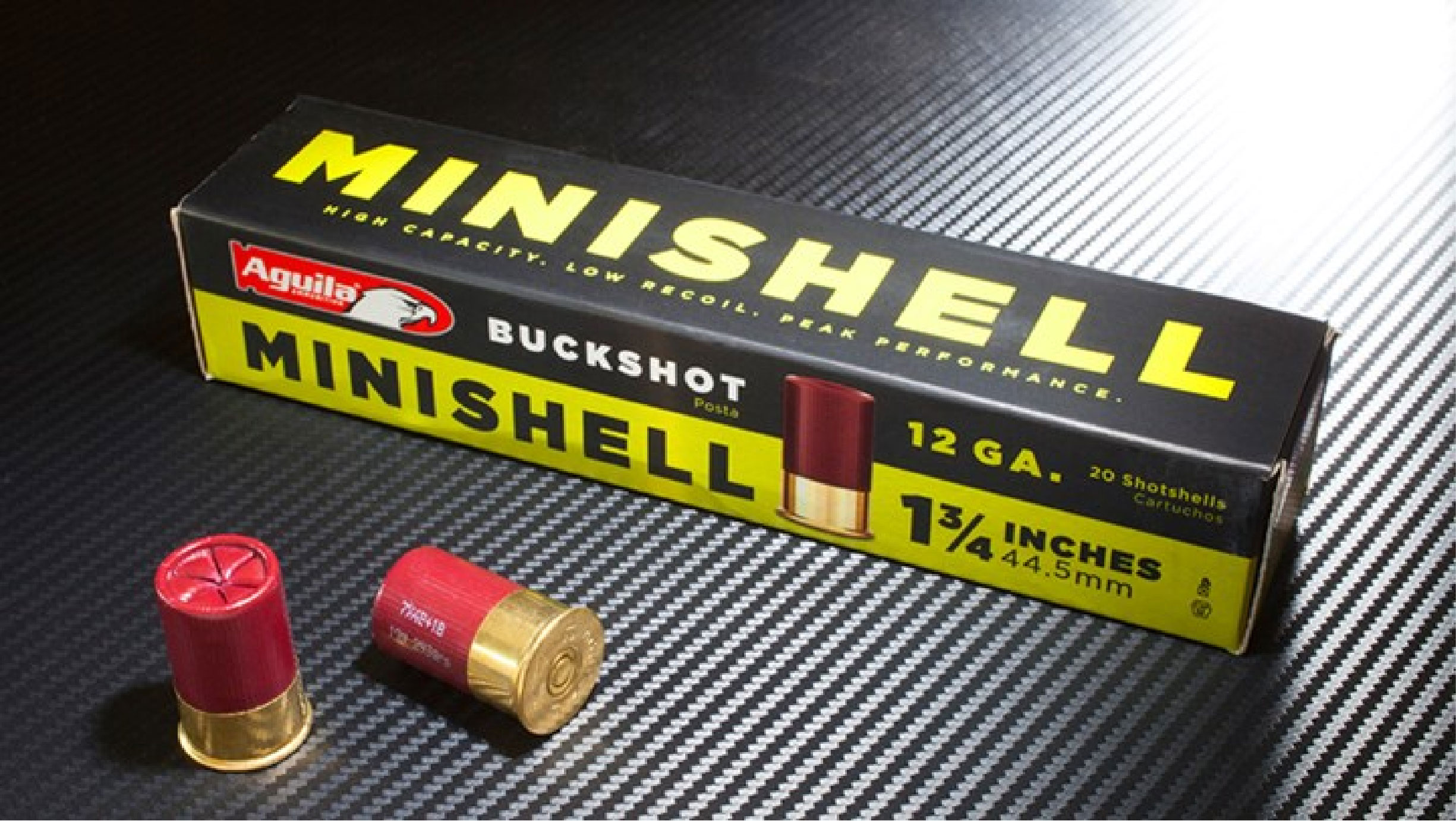
| Cartridge | 12 Gauge (18.53mm/0.729 inches or .73 caliber) |
| Shell Length | 1-3/4″ |
| NonToxic | No |
| Shot or Slug Type | Lead Shot |
| Shot Size | 11 #1 and 7 #4 Buck |
| Buffered | No |
| Muzzle Velocity | 1200 Feet Per Second |
| Primer | Boxer |
| Corrosive | No |
| Reloadable | Yes |
| Barrel Type | Smooth Bore |
| Crimp | 6-Point Star |
| Number of Pellets | 11 |
| Gauge Bore | 12 Gauge |
Product Information – Aguila Minishell Ammunition 12 Gauge 1 ¾-inch 7/8 ounce Rifled Slug
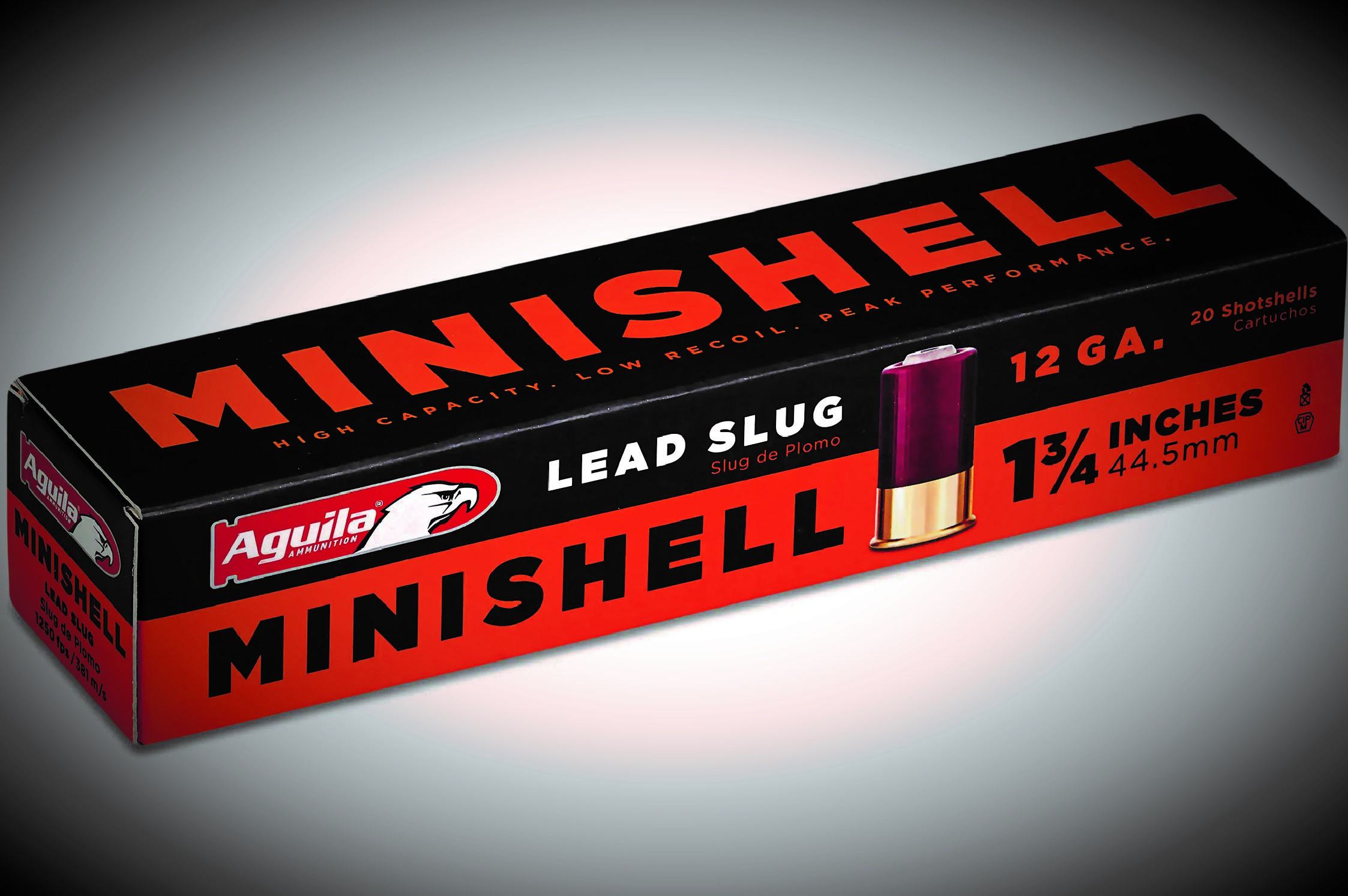
| Cartridge | 12 Gauge (18.53mm/0.729 inches or .73 caliber) |
| Shell Length | 1-3/4″ |
| NonToxic | No |
| Shot or Slug Type | Rifled Lead Slug |
| Buffered | No |
| Muzzle Velocity | 1250 Feet Per Second |
| Muzzle Energy | 1328 Foot Pounds |
| Primer | Boxer |
| Corrosive | No |
| Reloadable | Yes |
| Barrel Type | Smooth Bore |
| Crimp | Roll |
| Slug Weight | 7/8 Ounce |
| Gauge Bore | 12 Gauge |
Note
I have a complete review of the Aguilla minishells at https://guntoters.com/blog/2018/08/26/opsol-mini-clip/.
For Comparison Sake
The Aguila Minishell Ammunition 12 Gauge 1 ¾-inch #4 and #1 Buckshot 11 Pellets exhibits a rated muzzle velocity of 1,200 feet per second. For comparison, the Remington Express Ammunition 12 Gauge 2 ¾-inch #4 Buckshot 27 Pellets has a muzzle velocity of 1,325 feet per second. Now, the Aguila Minishell Ammunition 12 Gauge 1 ¾-inch #4 and #1 Buckshot 11 Pellets has a combination of #1 and #4 buckshot while exhibiting a 125 feet per second reduction in muzzle velocity.
The Aguila Minishell Ammunition 12 Gauge 1 ¾-inch 7/8 ounce Rifled Slug is a 0.875 ounce lead slug that exhibits a muzzle velocity of 1,250 feet per second. The reduction in muzzle velocity, as compared to the Remington Slugger Ammunition 12 Gauge 2 3/4-inch 7/8 ounce High Velocity Rifled Slug with a muzzle velocity of 2,751 feet per second, is significant, with the Aguilla coming in at 1,501 feet per second slower.
To put this last comparison into perspective, The Sig Sauer V-Crown 180-grain JHP 10mm Auto ammunition is also rated at 1,250 feet per second, and that is a 0.40 caliber projectile. With the Aguila Minishell Ammunition 12 Gauge 1 ¾-inch 7/8 ounce Rifled Slug, we have a .73 caliber, 0.875 ounce slug traveling at the same velocity as a .40 caliber, 0.411 ounce single projectile. While shot placement is important, the frontal area and weight of the projectile means a lot when it impacts a target made of flesh, blood, and bone.
Even with the Aguila Minishell Ammunition 12 Gauge 1 ¾-inch #4 and #1 Buckshot 11 Pellets exhibiting a muzzle velocity of 1,200 feet per second, that means some serious destruction at close range, as it would be in a domicile, or even at close range outside of the domicile.
It appears that the Aguila Minishell Ammunition 12 Gauge 1 ¾-inch #4 and #1 Buckshot 11 Pellets and the Aguila Minishell Ammunition 12 Gauge 1 ¾-inch 7/8 ounce Rifled Slug is a 7/8-ounce lead slug has some serious potential for taking care of UCAP (Up Close And Personal) social encounters, but they do come with a caveat – feeding issues.
The shells are obviously shorter than conventional 2 ¾-inch and 3-inch magnum loadings. As such they tend to bounce around in the loading area of all semi-automatic and pump shotguns. In a single-shot or double-barreled shotgun, this would not be an issue. I have read where the Winchester 1300 Defender pump shotgun seems to work best with minishells as compared to Remington and Mossberg shotguns, although Remington, because of the solid feed elevator, seems to handle them better, but not 100% of the time. Therefore, the use of minishells, at least the 1 ¾-inch variety is questionable because of feeding issues and not effectiveness of the ammunition. However, there are longer minishells than the 1 ¾-inch variety, such as the NobelSport 12 Gauge Ammunition 2.25-inch 6 Pellets 00 Buck, and I have read where most pump shotguns will chamber them without issue and have proven that fact with the Mossberg 500. However, they are not the topic for this article, but for a separate article?
With the feeding issue of the 1 ¾-inch shotgun ammunition, and especially with the Mossberg 590 Nightstick, some changes must be made to ensure that the shotgun will feed minishells reliable. And that is where part three of this article comes in.
The OPSol Mini-Clip 2.0 Flex
In August of 2018, I wrote a review article on the OPSoL Mini-Clip, and the review was very positive. My friend and shooting companion was instrumental in peaking my interest in shorty shotgun shells, after he converted his conventional Mossberg 500 to a pistol-gripped user-friendly shotgun around the same time as the article. In fact, the adapter found its way into one of my Mossberg 500 ‘tactical’ models where it has remained.
While I do have a few Mossberg 500 shotguns, and one Mossberg 590 Tactical shotgun, the idea of having a shorter-barreled shotgun enticed me, and thus the Mossberg 590 Nightstick was purchased due to several reason I have already mentioned. The Mossberg 590 Nightstick, like my Mossberg 500 Tactical, had to receive the OPSol Mini-Clip 2.0 Flex product, shown below.
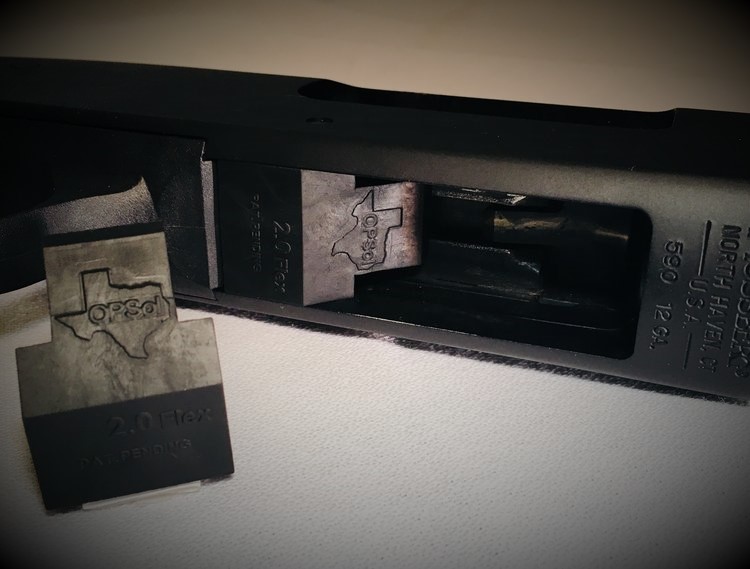

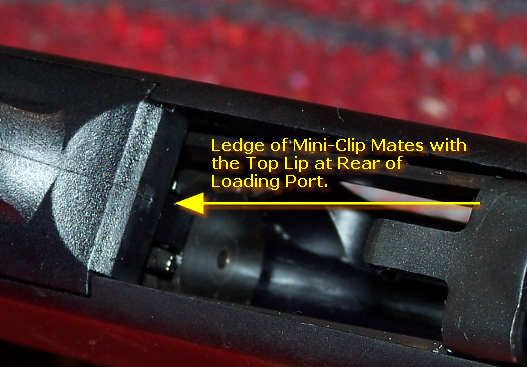
If you have not bothered to read the review article for the OPSol Mini-Clip, let me say here that the OPSol Mini-Clip 2.0 Flex installs quickly.
Installation Instructions
- Put gun on SAFETY. Ensure firearm is unloaded with no shells in the magazine cylinder/tube or chamber. Make sure pump slide is in extended position.
- Squeeze the sides of the OPSol Mini-Clip 2.0 Flex and insert the back flat end into the loading port at an angle.
- Push in so that the OPSol® Mini-Clip™ is in flush to the rear and the bottom. Rack the slide a few times to ensure the OPSol® Mini-Clip™ is in position. It should not move. If it does move, remove the OPSol® Mini-Clip™ and repeat steps 1, 2, and 3
It is also extremely easy to remove, should you want to run ammunition other than minishells:
Removal Instructions
- Put gun on SAFETY. Ensure firearm is unloaded with no shells in the magazine cylinder/tube or chamber. Make sure pump slide is in extended position.
- Rack the slide to the rear.
- Place a finger (your choice of fingers) into the ejection port and push the Mini-Clip downward and outward toward the rear of the loading port.
- Pull the Mini-Clip free of the receiver. The shotgun is now ready to receive standard-length 12-gauge shells.
Range Testing the Beast

Two shooting sessions were planned for this firearm; the first session was to run it as it comes from the factory, and the second session was to run it with my laser sight upgrade. My plan was to evaluate my performance (accuracy) more than the firearm, without and with a laser sight.
The Mossberg 590 Nightstick was taken from the box, quickly inspected for functioning, and then taken to the range after the required paperwork and transfer fee was taken care of.
For the first session, two silhouette targets were used for testing; one for buckshot at seven yards, which would be a good distance to test for (my) accuracy and spread of the Aguila Minishell Ammunition 12 Gauge 1 ¾-inch #4 and #1 Buckshot 11 Pellets. The distance of the slug target was set at seven yards to to check for (my) accuracy with this ammunition.
The second session, with rail and laser attached, will be an update to this article, or a separate article (Part 2), I have not quite decided which yet.
Author’s Note: The first session ran without issue, which I expected. The images that follow show the patterning and slug impacts at seven yards.

Two Rounds of Aguila Minishell Ammunition 12 Gauge 1-3/4″ #4 and #1 Buckshot 11 Pellets at 7 Yards
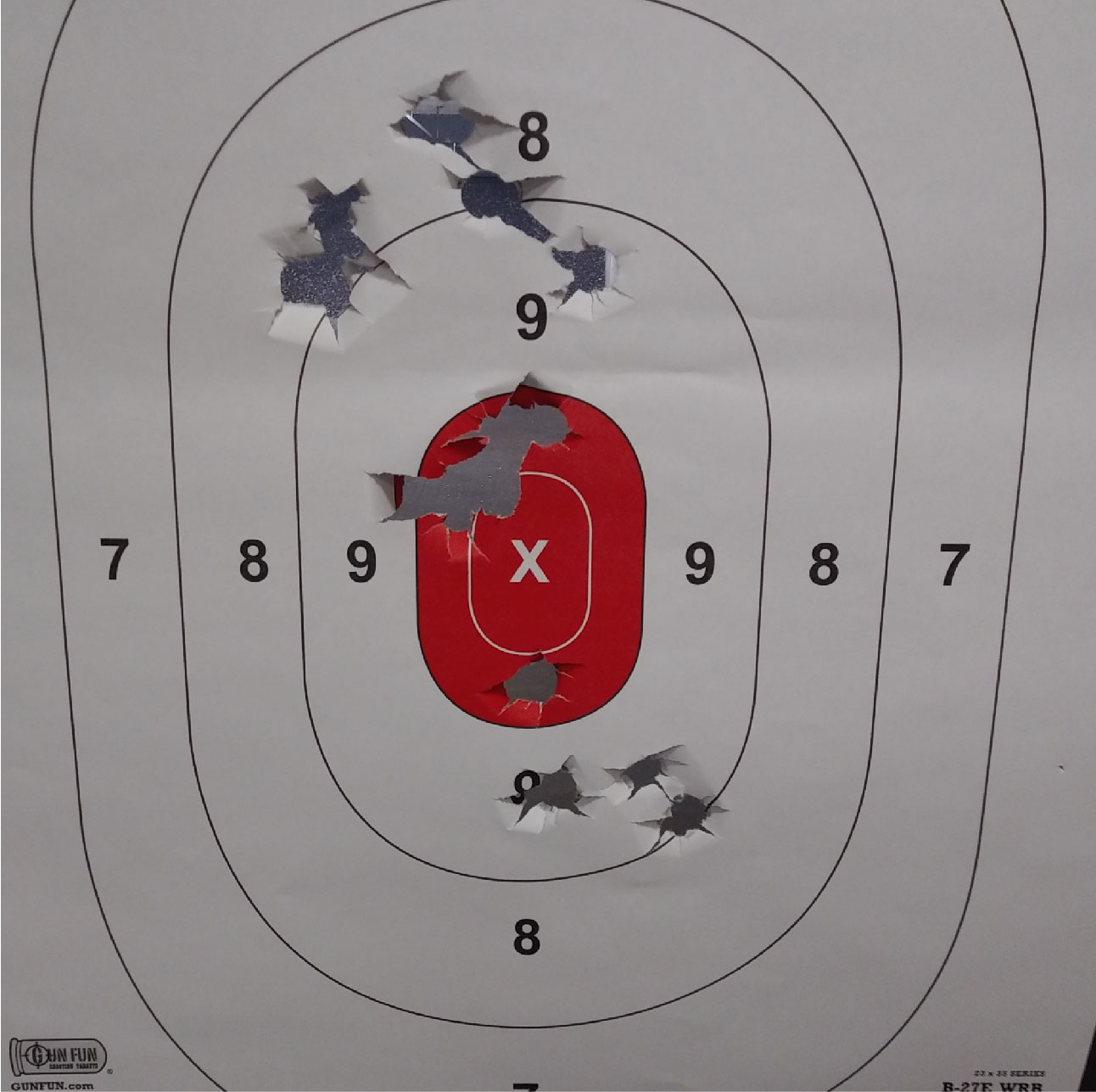
Six Rounds of Aguila Minishell Ammunition 12 Gauge 1 ¾-inch 7/8 ounce Rifled Slug at Seven Yards
Now, let us talk about recoil.
Recoil is mild even with the Aguila Minishell Ammunition 12 Gauge 1 ¾-inch 7/8 ounce Rifled Slug ammunition. The support hand (the one that works the pumper) endures most of the recoil. Surprisingly, I felt truly little of the recoil in the grip. Even with a firm grip on the pump handle, the recoil would force my hand to the front of the strap as the firearm recoiled rearward, for which I thank Mossberg for having the foresight to add the strap to the forearm. Under fast fire or when using wet hands to work the pump, the hand could go forward off the pump handle without the strap being in place, although the corncob forearm does provide a good gripping surface. The web of my pumping hand was rubbing against the strap’s mounting screws and I felt some irritation during the shooting session. A shooting glove helped to alleviate that problem. With that said, I probably would not have enough time to don shooting gloves when someone is intent on entering the domicile and doing harm to those within the domicile (domicilers?).
(Author’s Note: Any shotgun should be patterned for shooting pellets (birdshot or buckshot). Shotguns with long barrels, such as those used for hunting, may have a tight pattern when used for close work. Short-barreled shotguns; however, may have a greater shot pattern radius at the same distance; the longer the distance, the greater the spread. Choke size affects the pattern. At a given distance, the shot spread of a cylinder bored (not choked) shotgun will be greater than a shotgun that has a full-choke. Remember that we are not hunting. Distances from five to ten yards may be probable inside a house, and you must know the radius of your shotgun’s pattern at those distances. And going against conventional thinking, you do need to aim a shotgun for maximum effectiveness.
Refer to the image that follows for shotgun choke information.
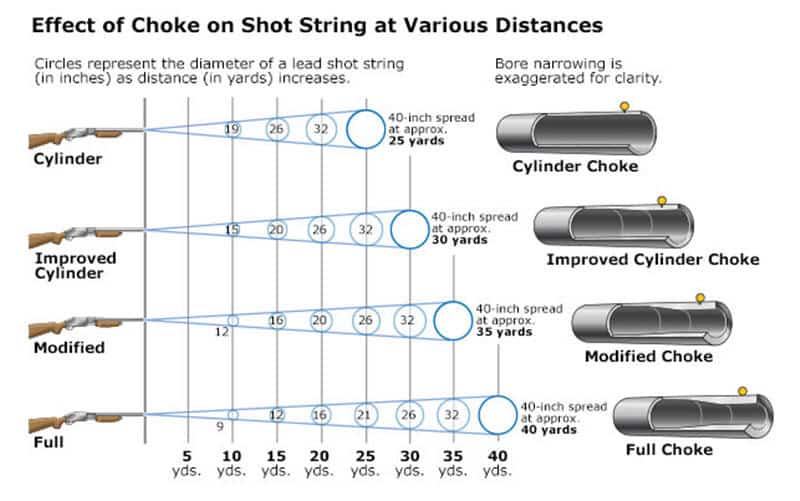
A Guide for Conventional Shotgun Patterning
With the OPSol Mini-Clip 2.0 Flex in place, one Aguila Minishell Ammunition 12 Gauge 1-3/4-inch #4 and #1 Buckshot 11 Pellets was loaded and chambered, which was then followed up by eight in the feed tube. You read that correctly, eight in the tube. The normal capacity of the Mossberg 590 Nightstick is 5+1 (2 ¾-inch shells), and I was going to up that by three.
When shooting a shotgun with a pistol grip, the support arm is fully extended. The shooting hand pivots the shotgun around the front sight. Although the Mossberg Nightstick might be classified as just another firearm, one still must grip the forearm and handgrip firmly. The mild recoil of minishells will not interrupt the front of the barrel that much. In fact, the recoil is much less than when shooting conventional loads.
What is bothersome, at first, is the angle of the hand on the forearm and handgrip; whereas, the handgrip angle is different than with a conventional pistol grip but is more like the grip used with a conventional stock, only with some of the stock missing. Unlike a conventional pistol grip, the hand is more horizontal than vertical. With a more horizontal angle, the grip tends to move rearward in the palm of the hand since there is nothing to brace against the shoulder; therefore, having a solid hold on the forearm and the raptor grip is essential. Hickok45 found out why while he was firing full loads out of a Mossberg 590 Shockwave. With the slick surface of the grip, when the shotgun recoiled his hand slid forward on the grip (or the grip moved inward), and the tang mounted safety injured the web of his shooting hand. His idea of a fix was to wrap hockey tape around the handgrip for a better gripping surface. My idea was to use a good shooting glove to prevent slippage of the handgrip in the hand. (See my other fix in Upgrades later in this article.)
Due to the light recoil, and good grip on the pump handle, the muzzle rise of the Mossberg Nightstick is truly little, even when shooting Minishell slugs. Therefore, I did not have to compensate as much as I would when firing conventional slugs. That I did not have to aim as low on the target as I normally would is a plus.
The shot pattern was exceptionally good with all shot remaining on target. On the slug target, impacts were predictable and center mass can become one big hole. With a 0.73 caliber, 0.875 ounce slug traveling at an estimated 1250 feet per second impacting something made of flesh, blood, and bone, there would be serious negative consequences and a life-changing experience, to include loss of life.
The paper silhouette targets used in the making of these range sessions were seriously harmed. To borrow a line used in the movie The Last Samurai, “It was a good death!”
Loading with Minishells
Minishells can be loaded in the conventional manner, but your convention may differ from mine. The Nightstick is light enough that you can hold it in one hand and load with the other. Some may prefer placing the firearm in the support hand and load while the firearm is upside down, and that is one way to do it if it works for you.
A lot of folks load one in the chamber, chamber the round, and then load through the magazine tube. One precaution arises when loading minishells, because they are short. It is possible that when you load into the chamber, the shell may bounce within the chamber and jam or reverse itself. For that reason, and unless I can view the loading port to ensure that the shell is oriented properly, I prefer to load the feed tube first with eight minishells (or the quantity of your choice), chamber the first round (with the safety on), and then top off the magazine.
Combat reloads can be performed as you normally would, stuff new shells in the magazine tube as needed.
Another method of loading is to lay the firearm on its side, with the slide to the rear, in your support hand holding the forearm. Then load one shell through the ejection port while observing the shell’s orientation. Once satisfied that the minishell is properly oriented, chamber the shell (with the safety on). Next, load the feed tube either from the same position or rotate the firearm so that the feed tube is facing upward enough to gain access to the feed tube.
Some practice will tell you what method works best for you.
Unloading Minishells
Loading minishells with the OPSol Mini-Clip installed is not a problem. What about unloading minishells? Obviously, shooting the darn shotgun until it is empty is a fun solution, but you may not be able to do that. For example, you have had the Mossberg 500 that is in the closet stoked with minishells and you want to unload it for PMCS (that’s Preventative Maintenance and Services for you not familiar with that acronym). Will the OPSol Mini-Clip interfere with unloading? The answer is no. Some like “shucking the corn” to unload the shotgun while others, like myself, like the more passive-aggressive approach and unload the shotgun by way of the magazine tube.
You will notice that the front of the OPSol Mini-Clip is slanted. This slant allows you to successfully load the magazine tube. The front slope will also allow you to successfully unload the magazine tube when stoked with minishells. However, you can remove the OPSol Mini-Clip and unload as follows:
Note: The following procedure assumes that a shell is chambered. Regardless, always perform steps 1 through 6 to check yourself by going through the motions anyway. (How long has the shotgun been stored loaded?) Always assume that a shotshell is chambered).
- Move the safety button to the rearward “Safe” position (it should have been there in the first place, even with an LNC (Loaded but Not Chambered) shotgun.
- Keep the muzzle in a safe direction.
- Press the lock lever and pull the forearm rearward, slowly until the live shotshell is completed extracted and visible in the ejection port. If there was no chambered shotshell, skip Step 4 and continue to Step 5. Otherwise, continue to Step 4.
- Remove the shotshell by hand.
- Pull forearm completely rearward to release the next shotshell onto the Elevator.
- Turn the shotgun so that the Ejection Port faces downward to allow the released shotshell to drop out from the Ejection Port.
- Push the forearm completely forward, closing the bolt without a shotshell being chambered.
- Turn the shotgun over so that the Trigger Guard is upward, and the shotgun remains in a safe direction.
- Insert the trigger finger into the Loading Port and press the Cartridge Stop (on the right side of the Receiver) inward to release shotshells one at a time. The shotshell will spring rearward once released by the Cartridge Stop, but the edge of the base may hit against the Bolt Slide. If this happens, simply lift the base of the shell slightly upward until it clears the Bolt Slide or pull the forearm slightly rearward until the Bolt Slide starts to move upward into the Receiver, thus freeing the shotshell from the Bolt Slide.
- Manually remove the shotshell from the receiver.
- Repeat Step 9 and 10 until all shotshells are removed from the magazine tube.
- Press the action lock lever and pull the forearm completely rearward.
- Visually inspect the chamber, elevator, and magazine tube to ensure the shotgun is completely unloaded.
Short-Shucking with Minishells
Just because minishells are being run through the shotgun, that does not mean that I can ‘short-shuck’ the firearm.
Short-shucking means that when you pull the forearm rearward you eject the fired shell (the hull), but the travel is not rearward enough to chamber the next round.
Practice shucking ALL the way back, not just far enough to throw out hulls. Even if you use minishells, you will not short-shuck if your muscles are programmed to open the action all the way to the stop.
Upgrades
The Mossberg Nightstick, being a Mossberg 590 platform, will accept any add-ons that you desire to include; a sidesaddle to carry extra shells, a 1913 Picatinny rail on top of the receiver for mounting optics, a heat shield for the barrel, a fiber front sight, and a different forearm with or without a vertical or folding pistol grip, just to name a few accessories. There is also a pistol brace with vertical pistol grip that is available.
I am on the fence about add-ons, but due to the nature of the Mossberg Nightstick, I can visualize a red or green laser mounted on a top rail. I had mounted a red laser unit with a rear push button on/off switch on my Mossberg 500 Tactical (see below image). I can just reach up with my shooting hand, without removing my hand from the stock, and activate or deactivate the laser with my thumb. The laser unit, once sighted in, helps in the pointing of the shotgun, especially when firing from the hip as the Mossberg Nightstick is intended, but is also useful when firing the shotgun at any position.
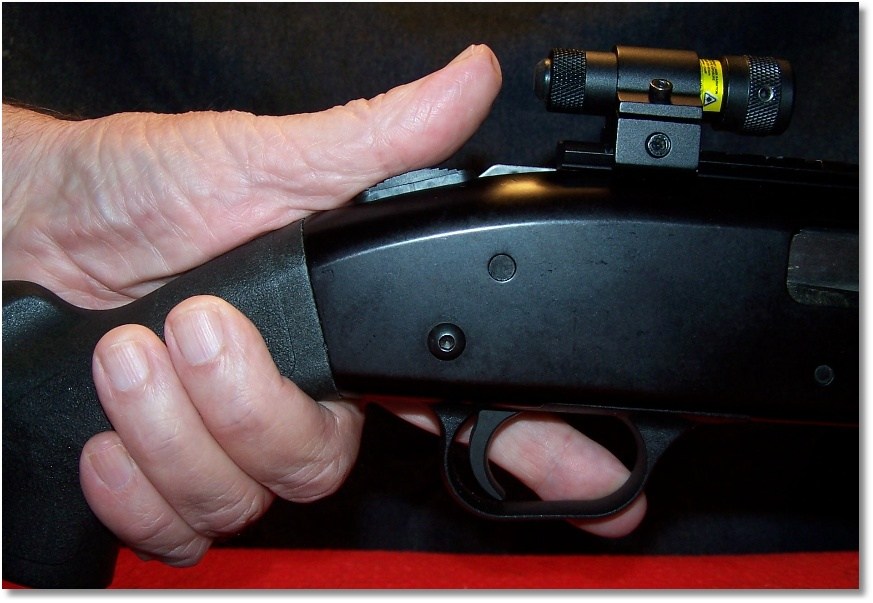
Mossberg 500 Tactical with Top-Mounted Laser
Since the handgrip of the Mossberg Nightstick is non-textured wood, it may be slippery in the hand, especially if the hands are wet. I can see a strip or two of Talon grip material, which would help the hand to stay in place. A good set of shooting gloves may help also for range practice, although I doubt if there would be time to don a shooting glove in the heat of the night.
Since the front bead can be washed out n bright sunlight, I opted to use the Hi-Viz Snap On Sight, shown below, to mitigate that issue. The Hi-Viz Snap On Sight simply snaps onto the barrel and locks into place against the front sight. I have used this sight on several shotguns, and it is a terrific addition. The sight is available from Amazon.com.
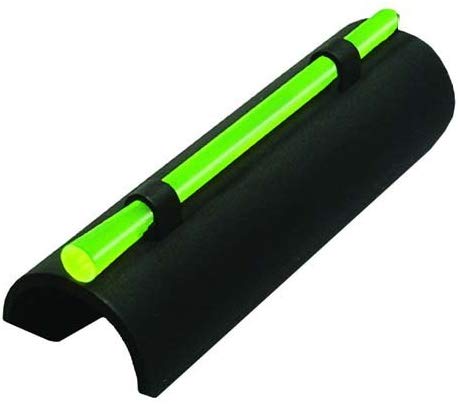
I have several two-point tactical slings that may work with the Mossberg Nightstick. This would allow close carry on the body and quick deployment of the firearm when needed. I have used these slings on an MSR, but some experimentation might be performed to determine if such a sling would work with this firearm, or if another type of sling would work.
No sidesaddle is planned. While I see their purpose and have installed and then removed them in the past on shotguns, they make the firearm cumbersome. If I cannot take care of business with 8+1 rounds…
I customized the Talon rubberized grip material that I had ordered for the firearm. Since I had wood furniture, I did not want to hide all the wood, but I still needed enough material to prevent my hand from slipping on the stock. My solution was to remove all material except for the side panels, as shown in the image that follows. (Note that I may swap the ‘moss’ version with the black rubber version, which may look better, later. Not that it matters to the bad guy, but it does matter to me).
The final upgrade was to re-mount the forearm strap. The strap allows even a gloved hand to wrap around the forearm. Taking off on a que by Hickok45, who put tape over the mounting screws, I thought why not simply re-mount the strap so that the mounting screws were on the outside rather than on the inside of the strap? And that is what I did. The edges of the strap are well-finished and the reduction in interior size helps the hand to stay within the confines of the strap, even with a gloved hand (if the gloves are not too thick).
Final pictures and range results with the all updates mounted will come later.
Wrapping it Up
The Mossberg 590 Nightstick takes some adaptation on the part of the user. Most reviews that I have read on the firearm had comments regarding the use of the firearm, with most saying that it is nothing more than a novelty and fun to shoot at the range. Others recognized its use as a personal defense firearm, although most agreed that a shoulder-mounted shotgun or handheld pistol offered more promise as a personal defense firearm. I have to say that I agree with both sides of the argument, as the Mossberg Nightstick is a less stable firearm since it cannot be shoulder mounted. The Mossberg Nightstick, like any other firearm, must be aimed, and a top-mounted laser (see Upgrades) can help in that department.
The Mossberg 590 Nightstick is a different type of firearm, although it is very closely related to the perception of a shotgun, by legal definition it is not.
If you are used to operating a pump-action shotgun, the manual of arms for the Mossberg 590 Shockwave will be extremely familiar to you. If you are used to firing a shotgun with a standard stock from the hip, or mid chest, the Mossberg 590 Nightstick will be operated the same way, with a push-pull method, and with the biggest difference being the 14-inch barrel and an abbreviated stock, which makes the Mossberg 590 Nightstick less cumbersome to handle; less than even with a shotgun with an 18-inch barrel.
Adapting to the less recoiling short ammunition will be welcomed, and that is really where the Mossberg 590 Nightstick shines with minishells; otherwise, the firearm can be quite brutal in recoil with full-power ammunition, and that brutality carries over in the muzzle blast and noise.
The combination of Mossberg 590 Nightstick, Aguilla minishells (or Federal), and the OPSol Mini-Clip 2.0 Flex makes for one excellent, compact package that can be used for home or personal defense.
I have dedicated this firearm to run minishells exclusively, with Aguilla 1-3/4 inch, 7/8 ounce slugs being my preferred choice of ammunition. And with a few upgrades, the firearm is now personalized and works better for me.
In closing, and as I mentioned, some are saying that the Mossberg Nightstick and other shotguns like it are simply novelties; fun to shoot but not necessarily good for personal or home defense. I say BS to that. While I will not say that the Mossberg 590 Shockwave and Nightstick are a self-defense panacea, but with practice and with low-recoil ammunition that can be easily controlled, I will say that it is a viable option for those who are interested in this type of platform.
As a very last note, the Mossberg 590 Shockwave and Nightstick are also available in 20-gauge; albeit, you will be shooting standard 20-gauge ammunition. However, we have found that the 12-gauge minishells have less recoil than even the 20-gauge.
Read Part 2 (https://guntoters.com/blog/2020/01/19/the-short-answer-to-home-or-personal-defense-part-2/) where I talk about the upgrades that were made to the Mossberg 590 Nightstick.
Resources
There are plenty of resources available regarding the Mossberg Shockwave and Nightstick that are available for reading and viewing. The following are just some that I found, and I am sure that there are more.
- Shotgun for Home Defense? Try the Aguila MiniShell| Guns & Gear S10: https://www.youtube.com/watch?v=lm74HaC8ItQ
- Home Defense: Aguila 12ga. mini shells: https://www.youtube.com/watch?v=13LaTffG1K0
- 12 Gauge Mini Shells Warning: https://www.youtube.com/watch?v=EhCkc9KBQ-c
- Mossberg Shockwave and Aguila Mini Shells: https://www.youtube.com/watch?v=FgvAhS2yCT0
- Mossberg 590 Shockwave Review W/ Aguilla mini shells & Opsol adapter: https://www.youtube.com/watch?v=Rs40CJicOPk
- MOSSBERG SHOCKWAVE WITH AGUILA MINISHELLS: https://www.youtube.com/watch?v=A6vdUj7TUtw
- Mossberg 590 NightStick – Part 1 – It’s LOUD! :-): https://www.youtube.com/watch?v=8kLSRu3GB40
- Mossberg Shockwave vs Remington Tac-14 (Hickok45): https://www.youtube.com/watch?v=UzfreZBvyyI
- Is the Mossberg Shockwave a viable home defense gun?: https://www.youtube.com/watch?v=GrMTI7ZHDFE
- Sootch00: Mossberg 590 Shockwave – Defense Tool or Range Toy?: https://www.getzone.com/sootch00-reviews-mossberg-590-shockwave/?trk_msg=MJ546J0BAIJ4B85A78EKMS94G0&trk_contact=QBNLQB3RCKC2CN3T7SM0Q60DS8&trk_sid=T1RBUJB9EG9KHP9F75P0OOUSFK
- New Mossberg Shockwave: https://www.youtube.com/watch?v=Bn3GKQuf2Zs
- Clint Smith of Thunder Ranch Reviews the Mossberg 590 Shockwave: https://www.mossberg.com/clint-smith-of-thunder-ranch-reviews-the-mossberg-590-shockwave/
- Mossberg 590 Shockwave Review: https://www.youtube.com/watch?v=lycfv0POeAU
- OPSol® Mini-Clip™ Short Shell Shooting Solution!: https://guntoters.com/blog/2018/08/26/opsol-mini-clip/
- How To Clean & Lubricate A Mossberg 590 & 500 Series Shotgun (HD): https://www.youtube.com/watch?v=EMdRSVb9cLw
![]()

